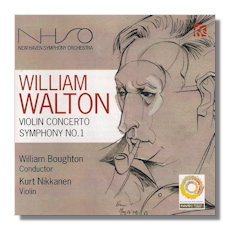

"William used to say that Paul's technique was marvellous, but that his playing was brusque he was a rough, no-nonsense player. Anyhow, it delighted him to see how well the work went down. The first rehearsal was a shambles…he had to stay up all night to redo the parts, so he was not feeling his best next day (3rd October 1929).

The orchestral parts were all wrong…and there was practically no rehearsal time allowed for the Promenade Concerts in those days.

Walton "offered to conduct himself, although he soon realised that this was a mistake.

The first performance at that Promenade Concert was not without its difficulties. Wood's Promenade Concerts are like their conductor, himself, a worthy institution at which the playing is so-so and never a sensation of the sort I am hoping for." Thankfully, Hindemith did play the Walton Viola Concerto, which he liked, and again quoting Lady Walton, "Playing William's Concerto endeared Hindemith to the British public more than any number of Courtauld–Sargent concerts could have done." Walton later admitted that he had been much influenced by Hindemith's own Viola Concerto even 'borrowing' several bars. An appearance with Wood to play a concerto by a moderately gifted English composer-and that is what Walton is-is not a fitting debut. He wrote to Gertrude, Hindemith's wife: "Your husband should make himself harder to get. When Strecker heard that Hindemith had instead agreed to play Walton's Concerto at a Henry Wood promenade concert at the Queen's Hall, he was furious. These concerts were extremely fashionable and very successful (each performance had to be given twice). Hindemith's publisher, Willy Strecker, the London manager of Schott, wanted to launch Hindemith as a viola soloist (he was a marvellous player) at a Courtauld–Sargent concert. Musical politics then raised its ugly head. To Walton's delight, Hindemith accepted to play the Concerto. He thought of transposing it so that it would become a violin concerto but Edward Clark at the BBC sent it to Hindemith in Germany. Alas, when he sent it to Tertis, the viola virtuoso sent it back by the next post declaring it too modern. At the time Walton confessed that he knew little about the viola except that it made a rather awful sound! "The only piece of viola music he admired and knew was Berlioz's Harold in Italy, which he thought quite beautiful, although it was not highly thought of in those days." Nevertheless, Walton rose to the challenge and proceeded with the task, finishing his Viola Concerto at Amalfi. According to Susana Walton, writing in her book, William Walton: Behind the Façade, Walton was somewhat perplexed and wondered why Sir Thomas thought he should be able to write such a work. The Viola Concerto It was Sir Thomas Beecham who suggested, in 1928, that Walton should write a Viola Concerto for Lionel Tertis. Yet his three string concertos are amongst the finest written this century." Of them Christopher Palmer has written, "Walton knew little or nothing of strings as a performer. Walton wrote three concertos for string instruments: the Viola Concerto (1929), the Violin Concerto (1939) and the Cello Concerto (1957). Of Writings by Lady Walton, Michael Kennedy and Christopher Palmer With an Extract from an Interview with Tasmin Little


 0 kommentar(er)
0 kommentar(er)
